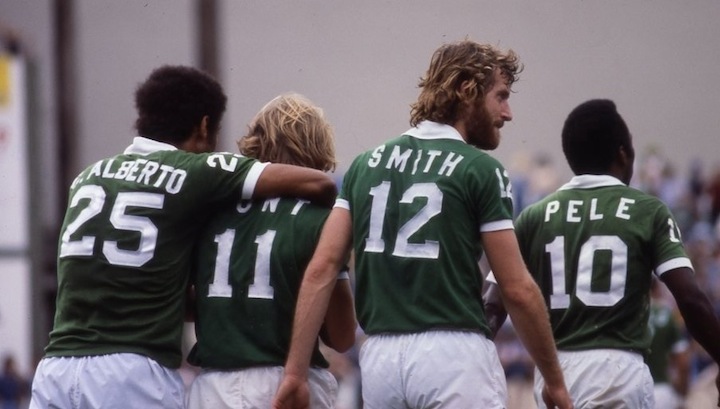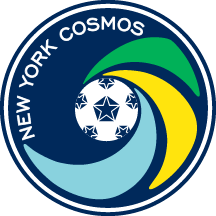News
Inside Cosmos Country with Historian Dr. David Kilpatrick (Part I)

By Cesar D.
With the home opener less than two weeks away we decided to kick off our season by interviewing Cosmos Historian Dr. David Kilpatrick, who is also a professor at Mercy College in Dobbs Ferry, N.Y. The interview took place during the annual 5 Points fundraiser at the Football Factory at Legends.
How did you become a soccer fan?
I’m a second generation American soccer player who was born in upstate New York. I learned the game from my father who in the late 1950s and early 1960s played upstate. He was an excellent athlete, so he was offered a scholarship to play soccer at Union College. He loved the game and he taught me how to kick a ball.
What were some of your 70s and 80s experiences following the Cosmos?
Going to Giants Stadium with my father and grandfather were some fond memories because it was a bigger than life experience. To me, the team also represented the rock-and-roll side of them. I remember opening my program and seeing Mick Jagger listed as an International Consultant.
Watching Pelé’s last game on television was one of my favorite memories. As much as I enjoyed the game, I had no idea what he was talking about when he asked the crowd to repeat after him and say, “Love, Love, Love.”
At that time I had started archiving the Cosmos’ history. I believe the first Cosmos-related thing I ever collected was the replica coin from Pelé’s match at the Meadowlands against Santos back on October 1, 1977.
Prior to tonight’s 5 Points event, you gave a lecture at Mercy College. What was the lecture about?
My lecture was about Nietzsche and history. I was talking about the idea of using history and not thinking of it as something that you need to be a slave to or something static. History can be viewed as something that serves life rather than life serving it. It fits with the Cosmos pretty well, I think.
There are an awful lot of people who misunderstand [the Cosmos’] history. I believe they are misconstruing what the Cosmos achieved as a club when I was a kid. One thing I talk about is the “Pelé Effect.”
When I was a kid and you flew across the country, you a saw a bunch of baseball diamonds. Now, you see soccer fields and that’s because of Pelé and his signing with the Cosmos. He and the club literally changed the landscape in America. To not get full credit for that and to be viewed as some kind of destructive force is sad.
It’s sad how [the Cosmos] are viewed by some because there’s so much amnesia, antagonism, and apologetics that characterize the American game… so many misconceptions. It’s a current distortion that serves current hegemony, and that’s why it’s important that we’re active in embracing our history and celebrating it.
Before the Cosmos played their first ever match, what was the state of New York soccer in the late 60s and early 70s?
Prior to the Cosmos, the 1966 World Cup provoked an awful lot of interest for professional soccer. By 1967 there were professional soccer leagues, the United Soccer Association (USA) and the National Professional Soccer League (NPSL).
In addition to having two professional soccer leagues, there was the failed experiment of having the New York Skyliners (USA) and the New York Generals (NPSL) share Yankee Stadium. Entering 1968, both leagues merged and formed the NASL. Unlike the previous year when you had two professional New York clubs, the Skyliners had folded while the Generals played one season in the NASL.
By the time the Cosmos started in 1971, it wasn’t that there wasn’t any soccer in New York. In fact, the ’71 roster belies that misconception and it was clear that the players were from all over the world. Many of the players were drawn from the German-American Soccer League (GASL), which at that time represented a great cosmopolitan mix.
From the beginning, the Cosmos first general manager, Clive Toye, and player/coach Gordon Bradley had a dual focus where they emphasized both the local and the global sides of soccer.
Before the Cosmos played their first ever league match, Toye contacted the state department to inform them that the Cosmos were willing to travel to China for an exhibition tour. It was probably a bit of Toye’s showmanship and bravado but it illustrated the vision he had about the club at the global stage.
From the local perspective of things, Bradley maintained the relationships he had with GASL and other local soccer community leagues. One player who benefitted from the Toye-Bradley partnership was Werner Roth, who came up through Blau Weiss Gottschee.
When it comes to the Cosmos of that era the names Pelé, Chinaglia and Beckenbauer will pop into the minds of many. Where does Werner fit in Cosmos history?
Werner Roth is a player who came up from the New York’s soccer system. As a player, Werner was an outstanding center back. During his time with the Cosmos he was a player who fought to remain relevant on a team that eventually featured global superstars.
This was a guy who loved and lived the game. It’s a great story and much like Shep Messing and Bobby Smith, Werner’s story is one of a local talent that must not be forgotten.
Click here to read "Inside Cosmos Country with Dr. David Kilpatrick (Part II)"



